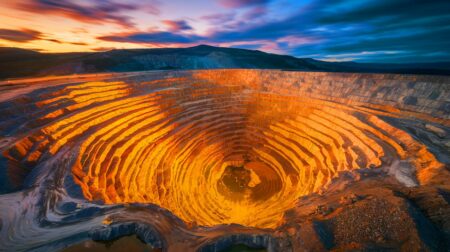| IN A NUTSHELL |
|
In a groundbreaking discovery, a colossal iron ore deposit has been unearthed in Western Australia, poised to revolutionize the global mining economy and reshape our geological understanding. With its immense economic potential, this finding challenges preconceived notions about planetary formation processes. As scientists and economists alike turn their attention to this newfound treasure, the implications for the future of mining and geology are profound. This discovery not only holds the promise of significant economic gains but also inspires a reevaluation of Earth’s geological history.
A Mountain of Iron: What Lies Beneath This Gigantic Deposit?
The recently discovered iron ore deposit is estimated to contain an astonishing 60 billion short tons of iron ore, boasting a potential value of approximately $5.775 trillion based on an average price of $95 per short ton. This revelation has the power to disrupt our current understanding of iron resources, challenging established geological processes. According to Dr. Liam Courtney-Davis, “this discovery could compel us to rewrite significant chapters on mineral formation and large-scale geological processes.” The sheer scale of this deposit forces scientists to reconsider how these massive iron formations came to be, prompting further research into Earth’s deep past.
Rethinking the Age of the Deposits
The importance of the Hamersley deposit extends beyond its sheer size. It challenges previous assumptions about the age of mineral formations, previously dated at 2.2 billion years, now reevaluated to 1.4 billion years. This shift is potentially linked to the cycles of supercontinents, offering a new perspective on historical terrestrial movements. A co-author of the study emphasized that “finding a connection between these massive deposits and changes in supercontinent cycles enhances our understanding of ancient geological processes.” This revelation invites scientists to explore the intricate relationships between geological timelines and the evolution of Earth’s surface.
Technology at the Forefront of Discovery
The discovery of this iron-rich treasure was made possible through advanced techniques such as isotopic dating and chemical analysis. These methods have facilitated a remarkable transformation, increasing the iron composition from an initial 30% to over 60% today. Such technological advancements are pivotal for predicting future mining explorations and encouraging the development of more efficient extraction strategies. The application of these methods not only enhances the economic viability of mining operations but also contributes to a deeper understanding of Earth’s mineral wealth and its origins.
The Global Economic Impact
Australia already holds a significant position in the global mining industry due to its vast iron reserves. With this new deposit, Australia is poised to strengthen its dominance, potentially influencing international trade agreements and the stability of iron prices. The implications extend beyond the mining sector, as they could lead to a reassessment of long-held geological hypotheses. This discovery energizes not only the mining industry but also the entire scientific community, urging the search for other massive deposits worldwide. Associate Professor Martin Danisík notes that “the exact timeline of these formations’ changes was not clear,” prompting further investigation to refine our understanding.
As this discovery unfolds, the world watches in anticipation of how it will transform both the mining industry and our comprehension of geological processes. What new insights and opportunities might arise from this monumental find, and how will they shape the future of Earth’s resources?
Did you like it? 4.6/5 (20)









Wow, 55 billion tons of iron? That’s a lot of rusty nails! 🏗️
How does this discovery affect local communities in Australia?
Is it environmentally sustainable to mine such a large deposit?
Does this mean my iron supplements will be cheaper? 😂
This is going to make Australia the iron king of the world! 👑
Just imagine the size of the pickaxe needed for that! 😜
Hope this doesn’t lead to geopolitical tensions over resources.
Are there any potential negative impacts on the environment?
Does this discovery mean we can expect cheaper cars in the future?
Can someone explain how isotopic dating works? I’m curious!
I’m skeptical about the impact on global iron prices. What do experts say?
This is a game-changer! Can’t wait to see how this unfolds.
Iron Man would be jealous of this find! 🦾
Why did it take so long to discover this reserve? 🤔
Could this discovery affect the stock prices of mining companies?
Hope this doesn’t lead to exploitation of local indigenous lands.
Impressive technology used here! Love seeing science in action.
How will this discovery affect Australia’s economy in the long run?
This article just blew my mind. Thanks for sharing!
I wonder if there are more hidden reserves like this elsewhere on Earth?
Could this lead to new technological advancements in mining? 🤖
I’m worried about the environmental impact. Any insights on mitigation measures?
Anyone else reminded of a treasure hunt? X marks the spot! 💰
Is this discovery as significant as it sounds or just media hype?
Why Western Australia? Is it especially rich in minerals?
Thanks for the in-depth explanation of the geological implications!
How will this affect the job market in the mining sector?
55 billion tons is unimaginable. How do they even calculate that? 🤯
Thank you for the detailed article! Very informative.
Who owns it?
Trump will now accuse Australia of ripping them off as they try to sell their iron overseas… global trade is a rip off ot seems to his made up lying math. Watch out for an invasion Australia!